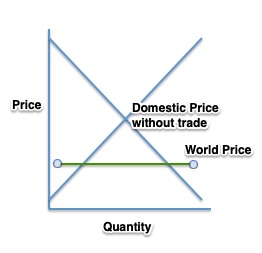I’ve been concerned that it can be tough to explain the upside of trade. So today, I wanted to give it a try.
Four-Stage Tariff Summary
But first, here is a four-stage 21-month tariff summary of the U.S. China trade war:
- January to June 2018: moderate increases
- July to September 2018: sharp increases
- September 2018 to June 2019: little change
- June 2019 to now: new increases
Chad Bown at the Peterson Institute graphed it all:
As trade barriers grow, we enjoy less of the following benefits from free trade.
Six Benefits of Free Trade
1. Free trade lets us specialize.
The iPhone 6 is our perfect example. Following a 500,000 mile (or so) journey when we add together the distance traveled by all of its components, we would have been looking at 24 primary suppliers, at three continents, and at two islands. However, we are really talking about parts “hopscotching” among a long list of manufacturing locations. Samsung alone has more than 80 sites, Toshiba, 50, and NXP, 35. Lastly, before the phone winds up in a store near us, a Chinese Foxconn plant probably does the FATP “final assembly, testing, and packaging.”
Still relevant, this iPhone 6 map is a handy way to imagine the journey:

2. Free trade expands the size of markets.
We can just look at a typical Tennessee cotton farm. When Planet Money looked at the travels of a t-shirt they started on a Mississippi cotton farm that could create 9.4 million T-shirts from its 2013 harvest. Because of the farm’s immense productivity it needs large markets:
3. Free trade lowers (per item) production costs.
Larger markets let us develop economies of scale. When you manufacture or harvest more, you can optimize the use of your machinery. You can take advantage of volume purchases. As Adam Smith told us in The Wealth of Nations (1776) through his pin factory, you can reap the benefits of a division of labor. As a result, per item production cost plummets.
4. Free trade creates domestic competition that lowers prices.
When the world price is less than a domestic price, consumers and businesses have the incentive to import cheaper items. Forcing the least productive firms out of business, trade nudges resources toward companies that are most productive.
Because the price in world markets is lower than at home, this country imports the item that the graph depicts:
5. Free trade increases variety.
Here again, Adam Smith got it. He also told us in his Wealth of Nations (1776), that nations limit what they produce when they try to do it all by themselves. Or as he said, “it is the maxim of every prudent master of a family never to attempt to make at home what it will cost him more to make than to buy.” So too for a nation.
6. Free trade encourages global cooperation.
Multilateral trade agreements can create bonds that unite disparate peoples. One example is today’s World Trade Organization where 164 countries have articulated and try to perpetuate rule-based trade.
The results?
Combining the six benefits of free trade, we wind up with higher average incomes, elevated living standards, and accelerated economic growth.
Our Bottom Line: Comparative Advantage
Free trade is a comparative advantage story. First expressed by 19th century economist David Ricardo, comparative advantage just means devoting your land, labor, and capital to whatever you do better. Then when others make what you don’t create and they too do it better, everyone is more productive.
To simplify, I purposely said “better.” More accurately, we are talking about opportunity cost. Each country needs to produce what results in the lower opportunity cost–the lower sacrifice. For example, if we assemble iPhones with our educated labor force, then we are sacrificing what they could instead be making. Meanwhile, in nations with cheaper unskilled labor, iPhone assembly requires much less of a sacrifice.
I know I should add that my six reasons for supporting free trade are vast oversimplifications that ignore the inequities and abuses. However, we can remember their fundamental validity.
My sources and more: My go-to website for trade, the Peterson Institute has an updated tariff timeline. From there, the Planet Money t-shirt series provides the perfect specific examples. And finally, a Greg Mankiw NY Times column presents an ideal defense of trade as does this paper.
Please note that several of today’s sentences were in a past econlife post.









